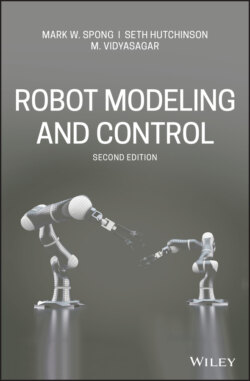Читать книгу Robot Modeling and Control - Mark W. Spong - Страница 14
1.1.2 The Configuration Space
ОглавлениеA configuration of a manipulator is a complete specification of the location of every point on the manipulator. The set of all configurations is called the configuration space. In the case of a manipulator arm, if we know the values for the joint variables (i.e., the joint angle for revolute joints, or the joint offset for prismatic joints), then it is straightforward to infer the position of any point on the manipulator, since the individual links of the manipulator are assumed to be rigid and the base of the manipulator is assumed to be fixed. Therefore, we will represent a configuration by a set of values for the joint variables. We will denote this vector of values by q, and say that the robot is in configuration q when the joint variables take on the values q1, …, qn, with qi = θi for a revolute joint and qi = di for a prismatic joint.
An object is said to have n degrees of freedom (DOF) if its configuration can be minimally specified by n parameters. Thus, the number of DOF is equal to the dimension of the configuration space. For a robot manipulator, the number of joints determines the number of DOF. A rigid object in three-dimensional space has six DOF: three for positioning and three for orientation. Therefore, a manipulator should typically possess at least six independent DOF. With fewer than six DOF the arm cannot reach every point in its work space with arbitrary orientation. Certain applications such as reaching around or behind obstacles may require more than six DOF. A manipulator having more than six DOF is referred to as a kinematically redundant manipulator.
